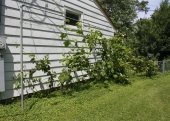Just made my best guesses and put in 5 citrus guilds.
In the center, Ponkan trees I started from seed. These are supposedly among the citrus that come true from seed. Hopefully so, the tree they came from makes delicious Ponkans.
I'm also going with the most freeze resistant citrus in the future. Ponkans and satsumas are high on the list of ones that can take freezes.
To make up the rest of the guild I've got named cultivars of Autumn Olive, which are invasive in some places but here in N FL they're not as quick to grow as elsewhere. out of all the Elaegnus cultivars I'm trying these have been the best in that they root from cuttings very easily and aren't struggling as much as the others I'm trying.
All the Elaegnus fix nitrogen.
Comfrey is the other "working" plant in the guilds. I think everyone knows about this so I won't go into detail on those.
I have a few Sunshine Blue dwarf blueberries in there but as tough as this particular cultivar is it doesn't seem to like the full sun it's supposed to need. They seem a ton happier in partial shade.
The guilds run from an area of partial shade to full sun so I can compare.
Something that's popped up in the last couple years nearby are mimosa trees. They too fix nitrogen. A lot of folks hate these because they're somewhat invasive, fragile, drop lots of litter and are susceptible to a number of disease problems.
having said all that the few that have volunteered over the years have always done fine here.
One of the other complaints is that the leaf litter has too much nitrogen in it. Maybe a problem for some but I'll take all the nitrogen I can get.
Haven't done it yet, but I'm going to work these into the guilds.
Even if something gets them they could be considered disposable with it being easy to grow more.
One other caveat there. The seeds are poison to dogs and other critters or livestock.
My dogs never showed any interest in them but that doesn't mean another dog won't eat them.
I laid out the support plants in a pattern like four spokes from a wheel hub. The idea there being not to have to tramp all over the lower plants harvesting the citrus.
The citrus guilds are also right by some oak trees. It's been discovered that oaks discourage the deadly citrus greening going around as long as they citrus is within 10 - 20 feet of the oaks.
One of the sad things about citrus greening is that you absolutely can not get citrus from another state and some of the frost hardy ones I would like to try just aren't available here.
I too took some terrible hits last few years with early frosts down in the teens. to counter that, I'm going to wrap some of the old greenhouse plastic around a cage made from 4 x 4 fence wire and have those standing by for freak freezes.
i think I'll leave them in place for the winter and pop a trash bag or some other plastic over the top if a bad freeze is coming in.
I was also reading about a fig grower who cuts the top and bottom out of plastic barrels and slips them over the trees for the first few years.
Here's a bit of a link dump:
Wild Citrus in a Florida Forest? Why It's a Big Deal.
https://www.youtube.com/watch?v=jtO0Pa6tD8s
https://blogs.ifas.ufl.edu/irrec/2020/01/21/oak-trees-may-hold-antibacterial-to-help-infected-citrus-trees/
Grasshoppers are a current problem with mine so maybe what's here might help
https://www.gardeningknowhow.com/edible/fruits/citrus/citrus-tree-companions.htm
http://www.thesurvivalgardener.com/growing-gardens-oak-trees/
cold tolerant citrus cultivars list. They can't ship out of state but this will give you some ideas what works
http://www.mckenzie-farms.com/photo.htm
https://www.lowtechmagazine.com/2020/04/fruit-trenches-cultivating-subtropical-plants-in-freezing-temperatures.html





